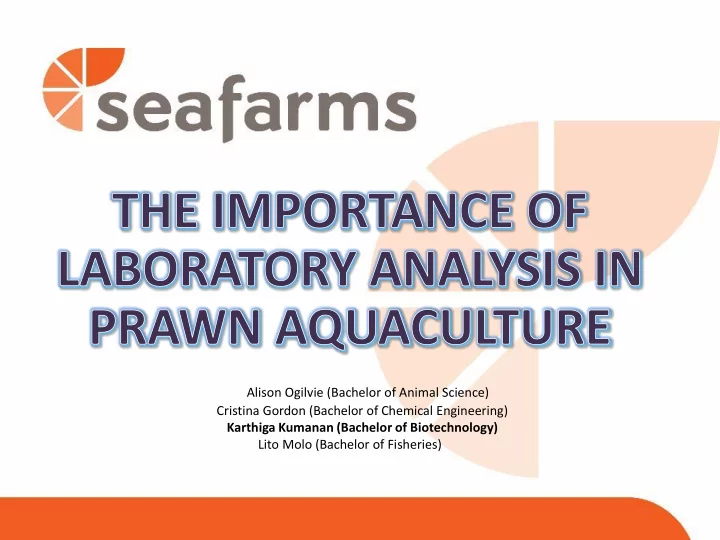

Alison Ogilvie (Bachelor of Animal Science) Cristina Gordon (Bachelor of Chemical Engineering) Karthiga Kumanan (Bachelor of Biotechnology) Lito Molo (Bachelor of Fisheries)
WHY NEEDED?? • Identify stressors rapidly in culture environment • Provision of evidence of freedom from pathogen WHERE NEEDED ?? • Identify the cause/origin of disease outbreak • Brood-stock facility • Hatchery • Grow-out
Hatchery To understand the source of contamination in case of disease outbreak – Cross contamination between departments Select pathogen free / minimal brood- stock for spawning To produce Vibrio-free algae Reduce bacterial load in Post-Larvae To ensure frozen feeds are free from pathogens : Squid, Polychaetes Minimise pathogen movement from hatchery to farm Ensure Larvae quality pass the farm quality standard.
Laboratory Analysis In Hatchery Method Assessment Area Water source Microalgae unit Larval rear unit Bacteriology Vibrio species Artemia hatching unit Spawing room Maturation room Brood-stock ponds Brood-stock WSSV Frozen feeds PCR Brood-stock PMMS Post larvae Frozen feeds Deformities Rostral Spine/ Shrimp Appendages Necrosis Fungal infection Microscopic observation Fouling Post larvae Muscle gut ratio Gut content and movement Size variation
Grow-out • Pre-stocking analysis • Active-surveillance • Post-harvest analysis/Pond preparation
Water Chemistry • Measure the toxic metabolites in culture environment • Total ammonia nitrogen • Nitrite nitrogen • Maintain high alkalinity for a stable pH • Phosphates, silicates and Calcium-Hardness
Pond bottom soil analysis • Soil analysis at multiple sampling locations within each pond • Organic matter analysis - % of organic matter present in pond soil - Lowest % of organic load is preferred • Soil pH – pH 7 • Apparatus & reagents are inexpensive and easy to purchase • Simple & no professional training required
Algal assessment • Benefits of phytoplankton bloom - Primary productivity for newly stocked PL - Prevent benthic bloom - Assimilate toxic metabolites & regulate DO • Understand which family of phytoplankton dominates the culture environment - Diatoms/Dinoflagellates/Cyanobacteria • Routine algal assessment - Prevent over blooming of unwanted phytoplankton • Cell count in case of HAB - To understand the severity of HAB - To assess the effectiveness of treatment
Bacteriology • Vibrio is common aquaculture related opportunistic bacterial pathogen • Quantify the potential pathogenic Vibrio in culture environment • V. parahaemolyticus .........Colonies with blue to green centers. • V. harveyi / V. fischeri ........Greyish-green to bluish-green colonies. • Luminous Vibrio are potential disease causing g agent.
Just visual inspection isn’t enough !!
PCR • Expensive??? NO • Rapid diagnosis of infectious disease • Quick turn-around time • Highly sensitive, able to identify the problem at an early stage • Important tool for surveillance in farm as well us water source • Minimise risk of disease spread by providing rapid result • Can be performed by any technician in a simple laboratory environment
Additional benefits of having an on-site laboratory • Cost benefit - avoids unnecessary treatment options - prevent major loss by mitigating the risk at an earlier stage - can be a tool for a better feed management to achieve lower FCR - improves hatchery/grow-out performance by achieving a better survival, growth rate & crop yield • Environmental benefit - able to quarantine the pond on time - allows to control disease outbreak from affecting neighbouring farms
Act proactively, not reactively 1) Identify the risk factor at earlier stage 2) Evaluate the whole batch 3) Control / mitigate
Contact Us Seafarms Group Limited Level 11, 225 St Georges Terrace Perth WA 6000 PO Box 7312 Cloisters Square WA 6850 T. +61 8 9321 4111 F. +61 8 9321 4411 E. info@seafarms.com.au
Recommend
More recommend